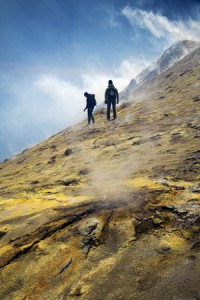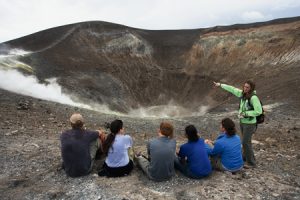Students and professors ascend Italian volcanoes and Swiss alps, hefting solid evidence of geologic processes into their backpacks.
Jets of red-hot lava and plumes of ash explode into the air above the rim of Mount Etna’s southeast crater. Fresh molten rock flows freely down the flank of Europe’s largest active volcano—the second eruption in a month’s time. Although such dramatic eruptions are almost commonplace to the Sicilians who live in Etna’s shadow, more than 7,000 miles away in Provo, an enthusiastic professor and two dozen BYU students are fired up at the news.
“We’re in luck! Etna began erupting again!” writes geological sciences professor Jeffrey D. Keith (BS ’77), in a message linking students to video of the spectacular displays. “I am praying that these eruptions will continue.”
Keith’s unusual prayers in support of natural disaster are motivated by the sincere desire to give students the ultimate mentoring experience. Each spring, the Geology Department takes students on a far-flung field study. The mentoring excursion—paid for largely by a scholarship fund started by retired geology professor W. Kenneth Hamblin (BS ’53)—gives students firsthand scientific experience in geologically fascinating places like Italy, Switzerland, Hawaii, and the Caribbean.
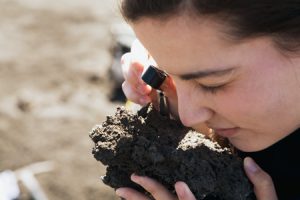
Looking for metal alloys, Nichelle Baxter examines a crusted lava bomb. Alloys in these volcanic chunks may indicate that a large ore deposit is brewing below.
Two weeks after Etna’s eruption, the BYU group leaves Provo armed with rock hammers, trekking poles, and gear for sand or snow. In 16 days they will travel nearly 15,000 miles on bus, plane, boat, and foot, traversing a line of volcanic activity and mountain building that stretches from Sicily to Switzerland. They will stop on rough trails and discuss such world-shaking concepts as volcanic eruptions, glaciation, and global warming. They will gather data and hundreds of pounds of field samples for a dozen different mentored research projects, some of which will be published in scientific journals, and for use in the classroom.
Exploring Etna
The sparkling Mediterranean coastline slowly fades as the BYU group ascends to the 10,900-foot summit, following their guides across pathless lava flows, mustard-colored sulfur beds, and fields of ash-dusted snow. Sulfurous gas from the gaping crater streams down Etna’s slopes, and the hikers have to be careful to avoid the eye-watering puffs.
Leading the way across the upper rim of the volcano, Carmelo Ferlito, one of two Italian guides, warns the students about the volcano’s violent and unpredictable outbursts. “We’ll stay a little way away from the southeast crater, which might erupt at any moment,” he says. When the students laugh, Ferlito responds, “No, it’s true. I’m not kidding.”
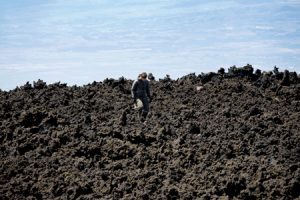
Jacob Hunter crosses a craggy lava field that is just two weeks old, hunting for mineral deposits before rain washes the elements away.
After stepping down onto a two-week-old lava riverbed—still cooling and crackling—all eyes scan skyward and contemplate the power, proximity, and peril of the nearby summit. Here Keith offers some timely advice. “All of you who have been praying for an eruption should now stop.”
Mount Etna’s jagged rim is a spectacular classroom for studying volcanic origins, processes, and landforms. The new lava flows are also one of the few places in the world where Jacob R. Hunter (BS ’07) can further his graduate research. Jake and his wife (and fellow graduate student), Elizabeth Moore Hunter (BS ’04)—who stayed home with the couple’s newborn twins—have been studying mineral deposits that are trapped in magma expelled during an eruption. Picking through Etna’s freshest lava clusters, Hunter discovers colorful shards of material in some of the rock. Lab results will be required to determine what they have found, but Hunter hopes to identify elusive mineral deposits that cling to the edges of “Swiss cheese–like” bubbles formed by chlorine and sulfur gasses during an eruption.
Keith encourages the students to find more promising rocks. “We hit the jackpot,” he says. “I’ll pay 10 euros to anyone who can find one.”
The phenomenon is not well documented because the minerals quickly leach away with exposure to the elements. “When rain comes down or the snow melts, it takes away all the things we’re looking for because they’re water soluble,” says Hunter.
As they collect several fresh samples with tantalizing but unidentified blue and pink shards, the students are excited by the rare find.
“We’ve looked for it in a few places,” says Keith, “but you have to find special conditions where the flows are very young. This is a very chlorine-rich volcano so we have perfect conditions and a protected environment since it hasn’t rained in the last two weeks.”
Although no one will make a fortune by mining ore deposits from the minute holes in volcanic rock, understanding these diminutive minerals is useful to the mining industry. Mining companies, as well as the National Science Foundation, take an interest in and fund many of Keith’s research efforts.
“When you have a concentrated deposit of copper, gold, or platinum, it’s formed in exactly the same way but only on a massive scale,” says Keith. “If we understand how these small deposits form, then we can help find large ore deposits.”
Etna does not erupt while the BYU group hikes and observes, so there is thankfully no need to try to outrun lava flows or to dodge smoking chunks of rock shooting through the air. But the smoking, recharging mountain still makes an impression.
“It’s one of the most volcanically active bodies in the world, and we get to stand right on the top of it,” says assistant professor of geological sciences Jani Radebaugh (BS ’93). “I picture this big body of magma underneath us just ready to erupt.”
The eruption-free conditions worked out just right for the Hunters’ mentored project with Keith. “Actually, if we had an eruption today we would not have been able to approach this flow and it would have been more detrimental to the research,” Hunter says, “I’m glad that this crater didn’t prevent us from coming so close.”
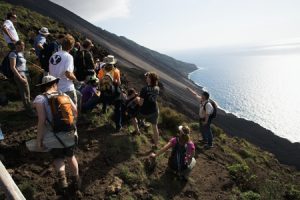
One side of Stromboli’s steep slope is completely ravaged. Jeffrey Keith pauses at a switchback to get students’ thoughts on the cause of this dramatic sector collapse.
Learning by Doing
Leaving the Sicilian mainland by ferry, the group of geologists meanders across the Tyrrhenian Sea to study how volcanoes formed the Aeolian Islands. After a short stop to hike Vulcano, the namesake of fiery fissures everywhere, they take a slow boat into the evening. After hours in darkness, the lights of the island Stromboli add a pattern to the night sky, then the island’s symmetrical shape gradually fills the view completely as the boat pulls in and docks.
Rising more than 3,000 feet from the sea, Stromboli extends underwater for another 3,000. This northernmost of the Aeolian Islands was the setting for a 1950 Ingrid Bergman film as well as the exit point for the fictional travelers in Jules Verne’s Journey to the Center of the Earth. The island’s round shape and warm filling also inspired the crusty calzone-like creation that shares its name. More important for geologists, the volcano is famous for its consistent “Strombolian activity”—cyclical, rhythmic, moderate bursts or fountains of expanding gases that often eject incandescent lava and molten rock bombs.
Early the next day, the bright morning sun increases the contrast of the quaint white-walled dwellings against a backdrop of lush greenery, and the BYU group gathers on the black sand beach to start working. On Stromboli, a textbook example of an island built by volcanics, graduate students Teagan L. Tomlin (BA ’05) and Christopher J. Spencer (’09) gather information and material to be used in meaningful, hands-on classroom exercises for Geology 370, Sedimentology and Stratigraphy. They hope to help the instructor, Thomas H. Morris (BS ’81), to design experiments and experiences that will convey abstract concepts to his students, helping them to think and act as they would in the field.
“We are going to see how the volcanic particles on the beach and then those farther upslope are affected by erosion,” Spencer says, “and see if the particles on the beach can be used to identify the explosivity of the volcano.”
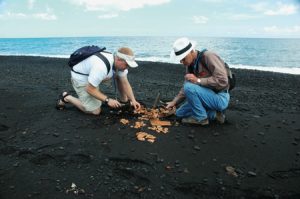
Jonathan Major and Norbert M. Larsen (MA ’60) break bricks apart on Stromboli’s shore. The terra-cotta pieces will be spilled into the ocean and videotaped to illustrate longshore drift; the film will be shown in future BYU classrooms.
Students and teachers spread out in an even grid to scoop up handfuls of the coarse sand into white cloth sample bags. Although to the naked eye the sand grains appear black and perfectly round, when magnified with a hand lens, they are revealed to be irregular, cratered grains of drab olive, amber, brick red, light gray—even pink and yellow.
“The whole purpose of our study,” says Tomlin, “is to see how the waves are interacting with the sediments, how they’re rounding them here and what influence they have on their texture and shape compared to sediments further up Stromboli.”
Video camera in hand, Tomlin records the wave action. “When we teach this principle in class, we can do it in a minute by showing this film,” she says. Together with samples, the video will enrich the learning experience for other BYU students.
More Ore on Stromboli
On a late afternoon hike up the volcano, the group eyes the Strombolian summit, occasionally clumping together for teaching moments and Q&As with professors at switchbacks.
Because the volcano erupted only months ago, Stromboli provides another opportunity to collect diminutive ore samples. Hoping to find these tiny deposits, graduate student Nichelle L. Baxter (BS ’06) searches for perfect “cow pie bombs,” rocky spheres of lava that appear fresh and unweathered.
“She’s trying to understand what happens to the element chlorine in this volcano that is exceedingly chlorine rich,” says Keith, lifting a cow pie bomb for the group to see, then passing the sample around. As chlorine escapes the volcano’s magma, Keith explains, it can transport metal ores from the magma chamber of the volcano. “So if we see little metal alloys in these rocks, then perhaps two kilometers down a giant ore deposit is being formed. That’s why we should care.”
After the group discussion, Keith consults with Baxter as she begins her search for more lava bombs.
“See this part right there?” he asks her, pointing at the outside edge of a sample. “See how glassy that is right there? So what we’re going to need to do is compare the glassy part with that interior part.”
“How many do we want?”
“Ten.”
Baxter collects and sorts through samples, breaking some in half. Picking one up and looking it over, she says, “This one is a good one. It’s crystalline in the interior and then it’s this really nice glassy nonweathered surface on the outside. We’ll be able to compare the chlorine contents on the chilled surface and see how it compares to the inside, where it’s more crystalline and cooled a lot slower.”
Above, Stromboli sits quiet, degassing but not providing any of the luminous evening explosions it is known for. The only fiery phenomenon the students witness is the sun sinking into the sea.
In the dark, her face illuminated by only a headlamp, Radebaugh reflects on the day: “How do you all feel, standing on the two most active volcanoes in the world and leaving without seeing an eruption?”
“I really like carbonate sedimentology about right now,” A. Riley Brinkerhoff (BS ’05) jokes. A female student chimes in from the dark: “Yeah, it never disappoints.”
“This is just the nature of field work,” says Radebaugh. “You might plan to do some field work, but Mother Nature is not always going to cooperate. I always make myself feel better by just saying that I’m going to come back.”
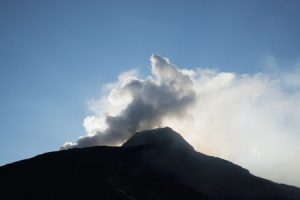
The sun crests Stromboli, silhouetting the Aeolian island built by volcanics. Unfortunately, the volcano sputtered only after students had already left.
The Earth’s Cold Shoulder
A flight from Naples to Milan and a bus ride to Aosta puts the students in the northern Italian Alps and marks a distinct shift in their field studies from volcanology to orogeny—the process of mountain building. With the majestic Matterhorn as a visual aid, grad student Nicole L. Cox (BS ’05) talks to her fellow students about the region’s tectonic and scientific history, part of her research into what the conditions—pressure, temperatures, and so on—were like in this region eons ago.
She explains that the Alps formed when the African and Eurasian tectonic plates crunched together, sandwiching an ocean basin between them. The pressure and heat of this monumental collision altered the minerals and oceanic materials, creating rocks of interest to geologists today.
To add expertise to this leg of the field trip, Summer Burton Rupper (BS ’00), assistant professor of geological sciences, flies in from Provo to share her knowledge of alpine glaciology.
That a southern girl named Summer would become an expert on glacial ice and global warming bears irresistible irony, but Rupper has developed some promising new techniques for studying the age of glacial ice. She talks enthusiastically with her students about the fascinating physiology of these rivers of ice and how they can impact the world’s climate.
Gorner Glacier in Switzerland—the last stop on the geology research field trip—is a 1,000-foot sheet of slowly flowing snow and ice, grinding and carving its way down the western Alps. Maps of the area show that even this mass is rapidly shrinking, jeopardizing the water supply of the area and also affecting such pedestrian concerns as skiing and tourism.
While the initial plan is for the entire group to conduct research on the glacier, then stay overnight in a nearby mountain hut, a storm system whites out the Matterhorn and threatens safety on the steep trails. Only an essential crew of five makes its way down from the train stop to sample the glacier. Joining them is Zurich resident Fabian T. Walter (BS ’02), a BYU physics alum who is now a PhD candidate at ETH Zurich, where he is part of a team monitoring the glacier’s hydrology, dynamics, and seismic activity.
As the team works its way down, the trail becomes wetter, steeper, and more treacherous with each additional snowflake and switchback. When the glacier finally appears through a thin layer of cloud, it looks like a frozen river, its banks lined with jagged slabs of dark slate.
Outfitted in heavy boots spiked with crampons for traction, student Brandon D. Crandall (’09) walks carefully near the bank of a stream that flows through the glacier. Suddenly, the icy bank collapses and, for a moment, he is in the water. “It’s all part of the job,” he says as he recovers his footing and scoops a sample of the stream water into a small glass bottle.
Grad student Rachelle Hart (BS ’05) records GPS coordinates, collects surface snow, then digs down with an ice axe to scrape a sample that looks like shaved ice. The temptation is too great, and she takes a bite.
“Now, you can touch the samples, but saliva will contaminate it,” says Rupper.
“Too bad,” says Hart, threatening to bag the sullied sample. But she quickly rethinks her actions. “All right, let’s do it again.” She scrapes some fresh ice and pops it into a clear sample bag.
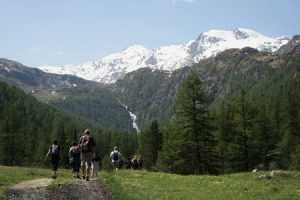
In the interim between volcanoes and glaciers, students toured the Alps, exploring the foothills of the Matterhorn and an old Roman mine where 5-centimeter garnets have been found. The massive sulfide and seafloor manganese deposits here are some of the best in the world.
“I’m collecting snow because the snow has a different source than the rivers or tributaries,” she says. “We are going to look at the isotopic difference between the snow and the water.”
While ice core drilling is an effective way to look back at the ice record, it can be slow and expensive. Rupper and her students are trying to find a cheaper, quicker way to take glacier samples. By comparing the seasonal isotopes—molecular differences—in the samples from the fresher surface snow with older layers underneath, the group can look at changes in the glacier’s temperature over time.
“The flow path in the ablation zone actually forces the snow to come to the surface, so as we go down-glacier we see older ice,” says Hart. “We want to know the difference in isotopes from year to year because then we can see if there’s a difference or what kind of effect man has had on it, exactly what kind of seasonal cycles we’re looking at.”
If this type of sampling proves to be as effective as drilling, more samples could be collected, providing more accurate information about glaciers, both regionally and globally.
“It’s cheaper and we can do a lot of them in a small amount of time,” Crandall says as he looks at the darkening sky. “And we don’t have that much time.”
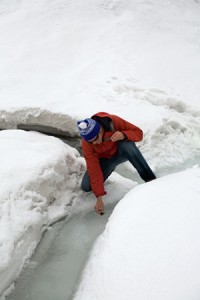 Rock Solid Returns
Rock Solid Returns
“The best geologists are the ones who have seen the most rocks,” says Jonathan R. Major (BS ’08), quoting famed geologist H. H. Read. Major is bringing home a backpack heavy with lava and alpine rocks and a head loaded with experiences. “I feel that I learned more in those two-plus weeks than at any other time.” Back at BYU, Major will work with Rupper to apply a computer model to the Swiss region the group visited, to better understand both the history and future of glaciers. He will later present their findings at the 22nd Annual Spring Research Conference and at the Utah Conference on Undergraduate Research.
As some planned projects are stymied by uncooperative volcanoes or weather, students learn patience, pitching in to help those still able to further their research. Whether samples—or experiences—are personal or project-related, every participant in the field study gathers something valuable to take home.
Spencer and Tomlin return to campus, energized by two weeks studying high mountains and volcanic islands, armed with bags of Strombolian sand that future students can hold and study firsthand.
Crandall is bringing home glacier water—double packed in plastic to prevent evaporation or contamination—that he,

No doubt, the Gorner Glacier in Switzerland is shrinking, but Rachelle Hart, Summer Rupper, and Brandon Crandall are taking measurements to find out how fast. Bagging samples of snow and water, they hope to prove that their cheap and fast sampling technique is comparable to expensive ice core drilling.
Hart, and Rupper will analyze in an Eyring Science Center lab.
Jake and Beth Hunter, Nichelle Baxter, and Jeffrey Keith will look closely at lava chunks and identify the unusual copper-, gold-, and silver-bearing alloys. The Hunters plan to publish their results in a major scientific journal, and Baxter’s work is her master’s thesis.
Keith concludes that geology in general, and these field trips in particular, provides a rare opportunity for students to better understand and appreciate our dynamic planet. “When you are able to learn how the earth was created, it gives you a sense of what God’s work is,” he says. “You can see an earth that He prepared for His children. He put ore deposits in easy reach, He made the earth habitable, and He made beautiful things all around us. I think it gives you, as a geologist, a unique awe for His creations.”
Feedback: Send comments on this article to magazine@byu.edu.







